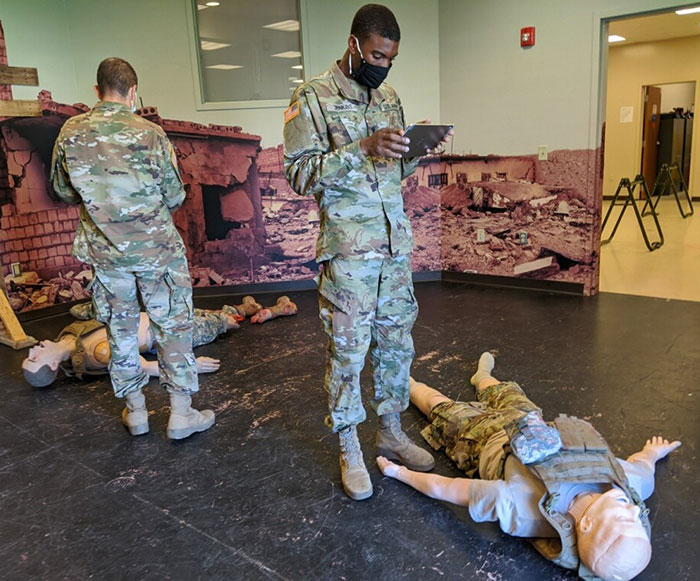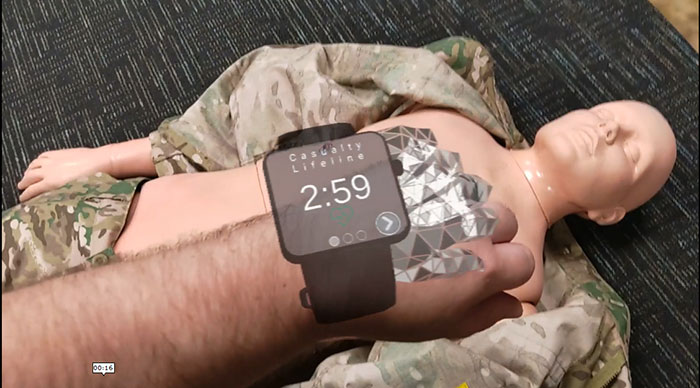Beyond Reality: New AUGMED Tool Pushes Limits of Medical Simulation

In a small multi-purpose activity room filled with socially-distant, mask-clad Soldiers attempting to learn the proper way to tie tourniquets and set splints, Chris Sandoval delivered one of his famous – and famously loud – rules of combat casualty care.
"Slow is slow," said Sandoval, a medical instructor at Fort Indiantown Gap (FTIG), speaking at top volume, "but efficient is fast."
For the one dozen Soldiers and Army Reservists participating in the U.S. Army Combat Lifesaver (CLS) Course at FTIG on September 22, it's a lesson worth remembering. So too, no doubt, is the method by which they learned some of the finer points of the CLS curriculum: via a brand new "extended reality" training tool developed by the U.S. Army Medical Research and Development Command (USAMRDC).
"It's a combination of augmented reality, mixed reality, and virtual reality all blended together to assist and support combat lifesaver classroom training," said JoAnn Archer, Senior Research Associate at Design Interactive, Inc., of the new AUGMED tool.
Funded by the USAMRDC's Medical Simulation and Information Sciences Research Program (MSISRP) – which initiated the effort via an Other Transaction Agreement (OTA) – the AUGMED is a multi-platform medical simulation tool designed to prepare Soldiers for the application of medical interventions in stressful or unpredictable situations. Training can be performed on both a standard tablet computer and, also, via a pair of Microsoft HoloLens virtual reality goggles; the latter of which stands the device's main draw and additionally provides for a deeper, more immersive experience.
"For example, when you turn your head, the goggles realize you're turning your head," said MSISRP Senior Program Manager Frank Karluk of goggle-driven option. "If there's supposed to be a fire over there or a vehicle over there, you're going to see that fire or vehicle or whatever the case may be."
"You see the real world in front of you," said Archer, whose firm teamed with MSISRP personnel to develop the technology,"but you also see virtual overlays or directions in your space."
Even without the goggles, however, the training modules remain the same. The AUGMED's tablet-driven option allows the user to scan, for example, any training mannequin (or, if they choose, even a live person) being used in any classroom or real-world setting and then insert that mannequin (or person) into the programmed training session. Once the simulation starts, the AUGMED allows the user to participate in a series of scenario-based training situations with real-time consequences. Still an additional feature allows for the application of specific lessons such as the treatment of massive, uncontrolled hemorrhage.

The insertion of the AUGMED into the CLS course at FTIG was designed as a stress test of sorts – as a way for both scientists and designers to gauge, in their words, the "usability" of the device and to obtain Soldier feedback as well. The long-term goal of the technology is to make Soldiers proficient in key life-saving skills at a faster rate and, also, to allow course participants to retain those skills over a longer period of time. Ultimately, MSISRP scientists hope they can help supplement the standard Army training regimen in new and different ways.
"The real goal is to make it as portable and functional as possible in a remote environment," said Karluk, noting the AUGMED's brand of "extended reality" training specifically targets the needs of overseas Soldiers who may not be able to attend group refresher classes on a routine basis. "We could send, for example, 30 tablets to Soldiers overseas, with each Soldier getting a tablet, and they'd be required to complete those lessons via scenario-based testing."
The combined team still needs to make substantial headway before that happens, however. In the immediate future, the team at Design Interactive, Inc. will take both the AUGMED and the day's feedback to their Orlando, Florida headquarters to iron out potential glitches before continuing down the path of ultimately fielding the device – an effort which could, according to Karluk, take place within a year.
Indeed, while nothing will ever replace Sandoval's brand of boisterous, hands-on teaching techniques across the Army at large, the AUGMED may, in its own way, provide the kind of unique medical training required for the future battlefield and beyond.
"The real bang for your buck is being able to capture that immersion," said Archer. "The Soldiers have been interested in trying it, and they've given us very candid feedback."














